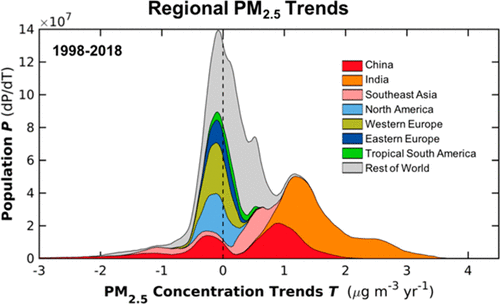当前位置:
X-MOL 学术
›
Environ. Sci. Technol.
›
论文详情
Our official English website, www.x-mol.net, welcomes your
feedback! (Note: you will need to create a separate account there.)
Global Estimates and Long-Term Trends of Fine Particulate Matter Concentrations (1998-2018).
Environmental Science & Technology ( IF 10.8 ) Pub Date : 2020-06-03 , DOI: 10.1021/acs.est.0c01764 Melanie S Hammer 1, 2 , Aaron van Donkelaar 1, 2 , Chi Li 2, 3 , Alexei Lyapustin 4, 5 , Andrew M Sayer 4, 5 , N Christina Hsu 4 , Robert C Levy 4 , Michael J Garay 6 , Olga V Kalashnikova 6 , Ralph A Kahn 4 , Michael Brauer 7, 8 , Joshua S Apte 9 , Daven K Henze 10 , Li Zhang 11, 12 , Qiang Zhang 13, 14 , Bonne Ford 15 , Jeffrey R Pierce 15 , Randall V Martin 1, 2, 16
Environmental Science & Technology ( IF 10.8 ) Pub Date : 2020-06-03 , DOI: 10.1021/acs.est.0c01764 Melanie S Hammer 1, 2 , Aaron van Donkelaar 1, 2 , Chi Li 2, 3 , Alexei Lyapustin 4, 5 , Andrew M Sayer 4, 5 , N Christina Hsu 4 , Robert C Levy 4 , Michael J Garay 6 , Olga V Kalashnikova 6 , Ralph A Kahn 4 , Michael Brauer 7, 8 , Joshua S Apte 9 , Daven K Henze 10 , Li Zhang 11, 12 , Qiang Zhang 13, 14 , Bonne Ford 15 , Jeffrey R Pierce 15 , Randall V Martin 1, 2, 16
Affiliation

|
Exposure to outdoor fine particulate matter (PM2.5) is a leading risk factor for mortality. We develop global estimates of annual PM2.5 concentrations and trends for 1998–2018 using advances in satellite observations, chemical transport modeling, and ground-based monitoring. Aerosol optical depths (AODs) from advanced satellite products including finer resolution, increased global coverage, and improved long-term stability are combined and related to surface PM2.5 concentrations using geophysical relationships between surface PM2.5 and AOD simulated by the GEOS-Chem chemical transport model with updated algorithms. The resultant annual mean geophysical PM2.5 estimates are highly consistent with globally distributed ground monitors (R2 = 0.81; slope = 0.90). Geographically weighted regression is applied to the geophysical PM2.5 estimates to predict and account for the residual bias with PM2.5 monitors, yielding even higher cross validated agreement (R2 = 0.90–0.92; slope = 0.90–0.97) with ground monitors and improved agreement compared to all earlier global estimates. The consistent long-term satellite AOD and simulation enable trend assessment over a 21 year period, identifying significant trends for eastern North America (−0.28 ± 0.03 μg/m3/yr), Europe (−0.15 ± 0.03 μg/m3/yr), India (1.13 ± 0.15 μg/m3/yr), and globally (0.04 ± 0.02 μg/m3/yr). The positive trend (2.44 ± 0.44 μg/m3/yr) for India over 2005–2013 and the negative trend (−3.37 ± 0.38 μg/m3/yr) for China over 2011–2018 are remarkable, with implications for the health of billions of people.
更新日期:2020-07-07











































 京公网安备 11010802027423号
京公网安备 11010802027423号